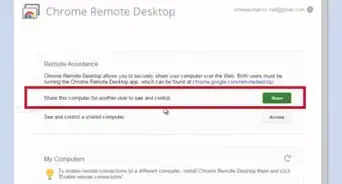This article was co-authored by Harish Chandran, PhD. Harish Chandran is the Engineering Site Lead and Senior Staff Research Engineer at DeepMind, where he leads the engineering efforts to integrate AI research results into Google products. Harish received his PhD in Computer Science from Duke University in 2012. While in graduate school, he worked as a Teaching Assistant, helping undergraduate students learn about algorithms and data structures. He has experience in DNA self-assembly, evolutionary algorithms, computational neuroscience, complexity theory, computer architecture, and super-computing.
There are 9 references cited in this article, which can be found at the bottom of the page.
wikiHow marks an article as reader-approved once it receives enough positive feedback. In this case, several readers have written to tell us that this article was helpful to them, earning it our reader-approved status.
This article has been viewed 142,414 times.
You’re moving on from your current job, whether it’s for a promotion or new company. There’s just one last thing to do: training the new employee who’s taking on your role. We’re here to help you get everything sorted out so you’re ready to move on to that new chapter of your career knowing that your old position is in good hands. Keep reading to learn everything you need to start the transition.
Steps
Preparing for Your Trainee
-
1Give your notice. Often, you will be training someone to do your job because you are moving into a new position within your organization. However, if you are leaving your current company, you need to give appropriate notice so that your employer know your position needs to be filled.[1]
- Look at your employment agreement for any specific details regarding giving notice. Contracts or agreements may include language regarding how far in advance you give notice, and what medium is appropriate.
- If your company does not have their own language regarding resignation, know that the standard is to give your employer two weeks notice before you leave, and that it’s appropriate to both meet with your supervisor to discuss your departure, as well as give them a written statement regarding your intent to leave the company.
-
2Set down standard operating procedures. Regardless of how well you train a new employee, they are not likely to remember everything from training. Develop a set of written procedures that detail step-by-step how to do your position. These procedures should include instructions on daily tasks, as well as how to conduct larger projects and processes in which you are involved.
- Ask your supervisor if there is a template for standard operating procedures in your company. Using a template will help keep things consistent for your trainee and make the writing process easier for you.
- Begin by detailing your daily duties. Explain, step-by-step, what you do each day when you come in.
- Once you have the daily routine established, detail larger processes and projects your trainee will be expected to pick up.
- Map locations for anything stored digitally, and use charts and screenshots liberally so that the trainee can pair your instructions with helpful visual aids for each step.
- Screenshots are especially helpful for anything you use that may be proprietary, such as databases, content management software, business to business software, or anything you would consider “in-house.”
EXPERT TIPHarish Chandran is the Engineering Site Lead and Senior Staff Research Engineer at DeepMind, where he leads the engineering efforts to integrate AI research results into Google products. Harish received his PhD in Computer Science from Duke University in 2012. While in graduate school, he worked as a Teaching Assistant, helping undergraduate students learn about algorithms and data structures. He has experience in DNA self-assembly, evolutionary algorithms, computational neuroscience, complexity theory, computer architecture, and super-computing.Machine Learning Engineer & PhD in Computer Science, Duke University
 Harish Chandran, PhD
Harish Chandran, PhD
Machine Learning Engineer & PhD in Computer Science, Duke UniversityLook back on your own training process for inspiration. Harish Chandran, the Engineering Site Lead for AI research company DeepMind, say: "The best way to train new employees is to have a really good onboarding experience and thorough documentation. Think about your training, including what worked for you and what didn't, and brainstorm potential solutions to any problem points. Use that information to create a knowledge base that would be beneficial for a new hire. Then, if you can, try to plan for the employee to spend their first month or so learning that information."
Advertisement -
3Arrange a space. For a time, you and your trainee might be sharing a space. Make sure you and your trainee both have space to work without interfering with one another. If you are moving into a new position, you may want to ask if your new desk is ready while you are training your replacement.[2]
- Make sure your trainee’s space is set up with what they need to fully perform their position. This includes getting them any permissions they may need for computer, software, and phone access, any keys they may need, or anything else pertinent to the specific position.
-
4Set a schedule. Make sure you cover every topic important to your trainee by setting a schedule before you begin training. List every topic you want to cover with your trainee, and set aside the necessary block of time to make sure you can take them through the process.[3]
- Remember to include time in each training block for your trainee to review the process and ask you questions.
- Talk with your supervisor about their plans for the trainee to make sure your schedule fits theirs. If, for example, they plan on taking the trainee out to lunch one afternoon, make sure your training calendar is mindful of that time.
- Have a flexible attitude when it comes to your training schedule. If something unexpected comes up in the course of your job, bring the trainee along even if the time was slotted for a different task. This allows them to see the position in action and start applying what they have already learned.
-
5Acquaint yourself with your trainee. If you did not hire your trainee, ask your supervisor or HR department to provide you with copies of their resume, cover letter, and any other material they may have submitted with their application. Familiarize yourself with their background and experience so that you can see where they might already have experience, and where they may need more training.[4]
- Do not assume anything about your trainee. Their experience or background may be impressive, but they may not adapt quickly to the position.
- Likewise, their experience may be different than what you would have considered for the position, but they may still be very capable and quick to learn.
Working With Your Trainee
-
1Introduce yourself. Introduce yourself as a person, a co-worker, and a resource for your trainee. Give them more than just your name. Let them know a bit about your educational and professional background, and how long you have been in your current position. Give them a chance to relate to you so that they can also start relating to the position.
- Let your trainee know that you will act as a resource for them as they figure out the job. You may want to say, “I helped develop this database, so if you have any questions even after training, you can always give me a call.”
-
2Have a shadow period. The first day or two with your trainee, allow them to get adjusted to the company and the job by watching you work. Let them shadow you, either for the entire day or for the parts of the day where you will be handling your trainee’s eventual job functions.[5]
- Assist your trainee by offering to break down a process as you’re doing it or after you complete it.
- Let your trainee go over their notes with you, and help them fill in blanks or parts that they have missed.
-
3Create assignments. Much of your time in training will be spent explaining concepts and taking your trainee through tasks and duties. You want to actively engage your trainee in the position, though. Create assignments for your trainee to help them work through their job duties and review with them so that they can see their strengths as well as where they need to improve.[6]
- If, for example, you had a project that involved research and a summary of your findings, have your trainee repeat the research and the synthesis. Then, go over their work with them, paying equal attention to what they did well and what needs improvement.
- If you have an active project, find a task within that for your trainee to try. This not only engages them actively with the position, but prepares them for what they will actually be working on moving forward.
-
4Check in regularly. As training continues, you may be spending less time daily with your trainee. You still want to check in with your trainee on a daily basis, though. This lets them feel supported and allows them to work with you for as long as possible to learn the job.[7]
- Try to set aside 15 minutes every morning to talk with your trainee about what they will be working on that day, and help them set goals for the day ahead.
- Set aside another 15 to 30 minutes at the end of every day to talk with your trainee about what they accomplished and to answer any questions they may have.
Transitioning Your Position
-
1Let your trainee take the lead. As your trainee progresses in their training, allow them to take the lead on certain tasks and projects. Start by having them take care of the daily routine without your help. Then, when you feel comfortable with their ability to handle the day-to-day, allow them to take lead on a particular project or project component.
- There is no set time frame for when any one trainee should be taking lead on anything. Look at what your training schedule will allow. If you have a few weeks to work with your trainee, you may want to focus the last week on getting them independent. If you only have a few days, this may need to happen faster.
- Allowing them to take lead should mean that you are removing yourself from the process. Offer to assist your trainee if they want or need it, but otherwise leave it to them to perform the job functions.
-
2Build their relationships within the company. As you transition your position to your trainee, introduce them to other people who may be of help in completing their job. Look at those coworkers with whom you have worked in your position, and introduce your employee, explaining how, specifically, they may work with this person in the future.
- Make sure your trainee has the phone numbers, email addresses and any other contact information they may need to get in touch with these new contacts on their own.
- If possible, try to arrange coffee or lunch so that your trainee can really get to know the person and their job functions, rather than just stopping by their desk.
-
3Stop working. At some point before your trainee is completely on their own, you should schedule to stop performing your current job functions. If you are able, you may want to turn your attention toward your new position. Let your trainee take over the position while you still have training time with them so you are there in case they need help.
- Let your trainee know well in advance when you plan to have them fully assume the position. Explain to them, “I will be there if you need help or if something comes up that we haven’t covered yet, but otherwise you are going to be taking on the job completely.”
- Let your supervisor know in advance, as well, and have them communicate with trainee first starting that day.
-
4Perform a final review. At the end of the training period, do a final performance review with the trainee. This should primarily address their strength and growth, and place secondary emphasis on where they need to improve.[8]
- Ask your supervisor if they would like to sit in on this process to offer their praise and constructive criticism, as well.
- If you do talk to your trainee about areas where they may need to improve, do so through constructive criticism. Let them know that they are on the right track, and give them specific points of improvement on which to focus.
- Talk to your trainee about where they can seek additional training if they feel there is any area they want to strengthen. Provide them with names and contact information of resources both internal and external to your company.
-
5Leave the position. Once the training period has ended, stop performing your old job duties. If you are able, allow your trainee to come to you with questions as they assume the position. Do not, however, have others within your organization demand you perform functions that should be done by your trainee.[9]
- If you move to a different position in your current organization, talk to your new supervisor and let them know that you are being asked to perform tasks from your old position. See if they can speak with your old manager about transitioning responsibilities to your trainee.
- If you are leaving your organization, you are likely under no obligation to continue performing work them. Simply let your former employer know that while you appreciated your time with their company, you are not in a place to complete those job functions anymore.
Warnings
- Make sure your training program fits with your company. Go over it with your supervisor and get their approval to avoid complications once training begins.⧼thumbs_response⧽
References
- ↑ https://www.thebalance.com/two-weeks-notice-resignation-letter-sample-2063069
- ↑ https://humanresources.ku.edu/preparing-your-new-hire
- ↑ http://www.quickbase.com/blog/how-to-treat-a-new-hire
- ↑ https://www.thebalance.com/gone-in-thirty-seconds-how-to-review-a-resume-1919139
- ↑ http://www.brighthub.com/office/human-resources/articles/102286.aspx
- ↑ https://www.entrepreneur.com/article/239865
- ↑ http://yfsmagazine.com/2013/06/25/10-effective-ways-to-train-and-educate-new-employees/
- ↑ http://www.insperity.com/blog/how-to-conduct-a-new-hire-review-the-right-way/
- ↑ http://www.businessnewsdaily.com/8326-staffing-transition.html










































































